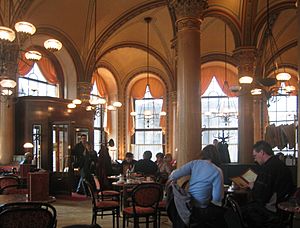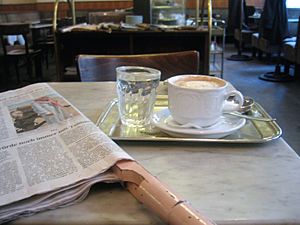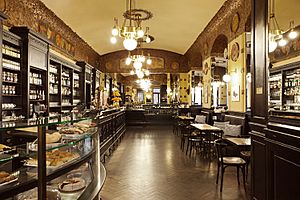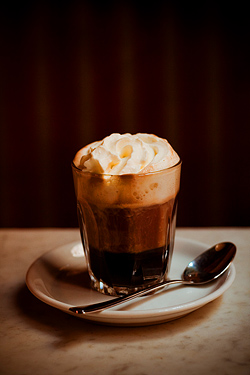Viennese coffee house facts for kids
The Viennese coffee house (German: das Wiener Kaffeehaus) is a special place in Vienna, Austria. It has played a big part in shaping the city's culture.
Since 2011, "Viennese Coffee House Culture" has been recognized by UNESCO. It is listed as "Intangible Cultural Heritage" in Austria. This means it's a valuable tradition that should be protected. The coffee house is described as a place "where time and space are consumed, but only the coffee is found on the bill." This means you can stay for a long time without feeling rushed.
Contents
What Makes Viennese Coffee Houses Special?

The unique feeling of a Viennese café comes from its social customs and elegant style. These coffee houses offer many types of coffee drinks. They also have international newspapers and delicious pastries. You will often see marble tabletops and Thonet chairs. There are also special tables for reading newspapers.
The Austrian writer Stefan Zweig called the Viennese Coffee House a special kind of "democratic club." He said anyone could visit for the price of a cheap cup of coffee. Guests could sit for hours, talk, write, play cards, and read many newspapers. Zweig believed these coffee houses helped Vienna feel like a worldwide city. This was because they offered so much news.
In many old cafés, like Café Central, you can hear piano music in the evening. They also hold events like literary readings. When the weather is warm, people can sit outside in a "Schanigarten" (outdoor seating area). Most coffee houses also serve small food dishes like sausages. They also have many desserts, cakes, and tarts. Popular choices include Apfelstrudel and Linzer torte.
It is very normal for a customer to sit alone for hours. They can read the many newspapers available. Along with your coffee, the waiter always brings a glass of cold tap water. If you stay a long time, they might even bring more water without you asking. This shows how much they care about their guests.
Coffee Houses and Famous Writers
In the late 1800s and early 1900s, many important writers loved Viennese cafés. They would meet, share ideas, and even write there. The literature written in cafés is called "coffee house literature." The writers are known as "coffee house poets." For example, the famous journal Die Fackel ("The Torch") by Karl Kraus was mostly written in cafés. Other famous writers included Arthur Schnitzler and Peter Altenberg. Peter Altenberg even had his mail delivered to his favorite café, the Café Central.
The Viennese coffee house culture also spread to other cities. These included Prague, Budapest, Krakow, Trieste, and Lviv. These cities were part of the Austro-Hungarian Empire. This created a special mix of cultures. Writers, artists, musicians, and thinkers met in these places. After many changes in history, this special atmosphere mostly stayed in Vienna. It also remained in a few other places, like Trieste. In Trieste, many old Viennese coffee houses still exist.
The History of Viennese Coffee Houses
A popular story says that the first coffee house started in 1683. This was after the Battle of Vienna. Soldiers found bags of strange beans. They thought they were camel feed and wanted to burn them. The Polish king Jan III Sobieski gave the bags to an officer named Jerzy Franciszek Kulczycki. He then supposedly started the first coffee house. This story was written in 1783.
The legend says Kulczycki added sugar and milk to the coffee. This created the Viennese coffee tradition. Many modern Viennese coffee houses have a picture of Kulczycki. However, recent research suggests that Vienna's first coffee house was opened by an Armenian businessman. His name was Johannes Diodato, and he opened it in 1685.
The new coffee drink became very popular. Coffee houses quickly opened all over the city. At first, the different coffee drinks did not have names. Customers chose their drinks from a chart based on color.
The Golden Age and Modern Times
The best time for coffee houses was around the year 1900. Writers like Peter Altenberg and Karl Kraus made them their favorite places to work and relax. Many famous artists, scientists, and even future political leaders visited these cafés. These included Arthur Schnitzler, Stefan Zweig, Egon Schiele, and Gustav Klimt.
In the 1950s, many famous Viennese coffee houses had to close. This was because television became popular. Also, modern espresso bars started to appear. But many of these classic Viennese coffee houses still exist today. People are now more interested in their traditions. Tourism has also helped them make a comeback. Some newer Viennese coffee houses have even opened in North America. These include Julius Meinl Chicago and Cafe Sabarsky in Manhattan. There is also a Viennese coffee house in the Austrian Hospice in Jerusalem.
Famous Viennese Coffee Houses
- Aida: A chain of traditional coffee and pastry shops. They have many locations, including one near Stephansplatz.
- Café Bräunerhof: Located at Stallburggasse 2.
- Café Central: Found in the Palais Ferstel, Herrengasse 14. This was Peter Altenberg's favorite café.
- Café Demel: At Kohlmarkt 14. This is a very famous sweet bakery, less of a typical café.
- Café Griensteidl: Located at Michaelerplatz 2. It was a favorite of Leon Trotsky and many writers. It closed in June 2017.
- Café Hawelka: At Dorotheergasse 6.
- Café Landtmann: On Universitätsring 4. This was Sigmund Freud's preferred café.
- Café Museum: Located at Operngasse 7.
- Café Sacher: At Philharmonikerstraße 4. This café is part of the Hotel Sacher.
- Café Savoy: On Linke Wienzeile 36.
- Café Schwarzenberg: At Kärntner Ring 17, near Schwarzenbergplatz.
- Café Sperl: Located at Gumpendorferstraße 11.
- Kaffee Alt Wien: At Bäckerstraße 9.
Images for kids
-
The Café Hawelka coffee house on a quiet Thursday morning
See also
 In Spanish: Café vienés para niños
In Spanish: Café vienés para niños









